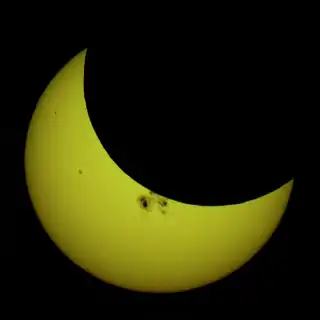| Solar eclipse of January 3, 1946 | |
|---|---|
 Map | |
| Type of eclipse | |
| Nature | Partial |
| Gamma | −1.2392 |
| Magnitude | 0.5529 |
| Maximum eclipse | |
| Coordinates | 67°06′S 177°36′E / 67.1°S 177.6°E |
| Times (UTC) | |
| Greatest eclipse | 12:16:11 |
| References | |
| Saros | 150 (13 of 71) |
| Catalog # (SE5000) | 9388 |
A partial solar eclipse occurred on January 3, 1946. A solar eclipse occurs when the Moon passes between Earth and the Sun, thereby totally or partly obscuring the image of the Sun for a viewer on Earth. A partial solar eclipse occurs in the polar regions of the Earth when the center of the Moon's shadow misses the Earth.
Related eclipses
Solar eclipses 1942–1946
This eclipse is a member of a semester series. An eclipse in a semester series of solar eclipses repeats approximately every 177 days and 4 hours (a semester) at alternating nodes of the Moon's orbit.[1]
Note: The partial solar eclipse on September 10, 1942 occurs in the previous lunar year eclipse set.
| Solar eclipse series sets from 1942–1946 | ||||
|---|---|---|---|---|
| Ascending node | Descending node | |||
| 115 | August 12, 1942 Partial |
120 | February 4, 1943 Total | |
| 125 | August 1, 1943 Annular |
130 | January 25, 1944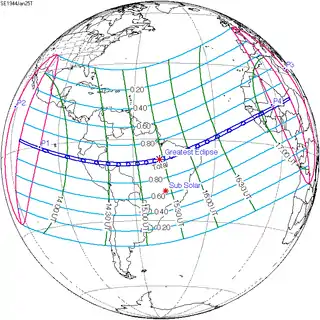 Total | |
| 135 | July 20, 1944 Annular |
140 | January 14, 1945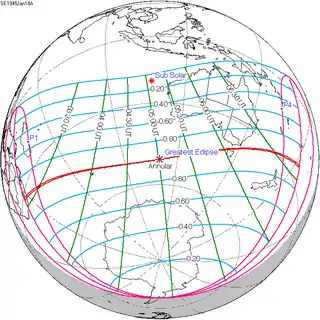 Annular | |
| 145 | July 9, 1945 Total |
150 | January 3, 1946 Partial | |
| 155 | June 29, 1946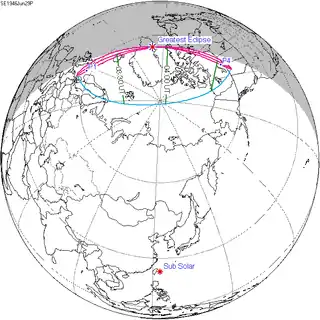 Partial | |||
Saros 150
It is a part of Saros cycle 150, repeating every 18 years, 11 days, containing 71 events. The series started with partial solar eclipse on August 24, 1729. It contains annular eclipses from April 22, 2126 through June 22, 2829. There are no total eclipses in this series. The series ends at member 71 as a partial eclipse on September 29, 2991. The longest duration of annularity will be 9 minutes, 58 seconds on December 19, 2522.
| Series members 11-21 occur between 1901 and 2100: | ||
|---|---|---|
| 11 | 12 | 13 |
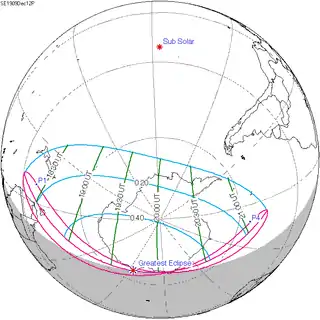 December 12, 1909 |
 December 24, 1927 |
 January 3, 1946 |
| 14 | 15 | 16 |
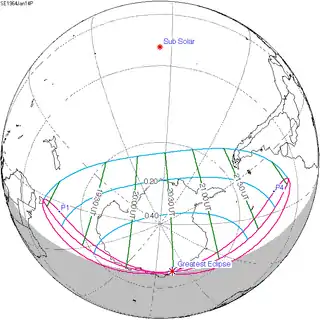 January 14, 1964 |
 January 25, 1982 |
 February 5, 2000 |
| 17 | 18 | 19 |
 February 15, 2018 |
 February 27, 2036 |
 March 9, 2054 |
| 20 | 21 | |
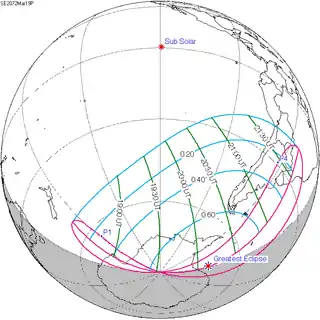 March 19, 2072 |
 March 31, 2090 | |
References
- ↑ van Gent, R.H. "Solar- and Lunar-Eclipse Predictions from Antiquity to the Present". A Catalogue of Eclipse Cycles. Utrecht University. Retrieved 6 October 2018.
External links
- Earth visibility chart and eclipse statistics Eclipse Predictions by Fred Espenak, NASA/GSFC
.jpg.webp)

